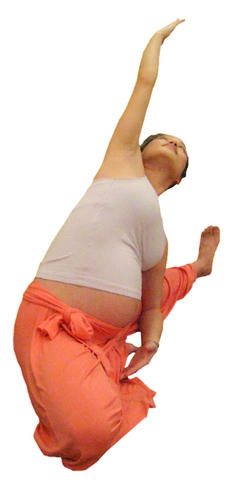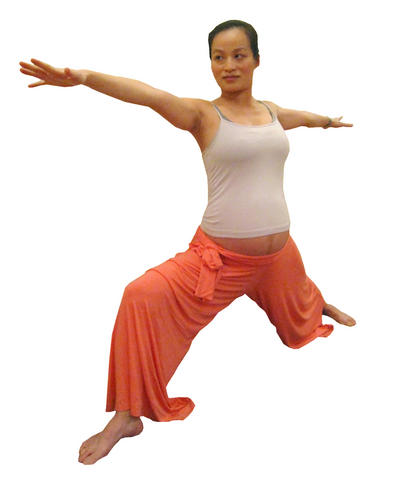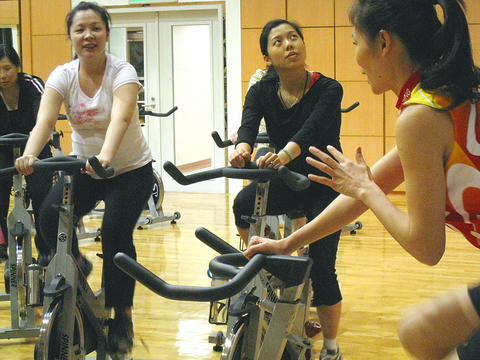ideas of the sedentary mother-to-be
with yoga and spinning classes
It is not much used now, but the term "confinement" in reference to the treatment of a pregnancy is resonant with the idea, still very much in vogue in Taiwan, that pregnant women suffer from an illness and should be prevented from engaging in virtually almost any kind of physical exertion.
In the West, this attitude began to change in the mid-1980s, and Taiwan is now realizing that there is not only a market for pre-natal exercise, but even a medical need. Taiwan Adventist Hospital has been among the first medical organizations in Taiwan to embrace this trend, and has established a number of pre-natal exercise classes over the past two years, the most recent being a spinning class for pregnant women.
In 1985 the American College of Obstetrics and Gynecology (ACOG) published its first guidelines for exercise during pregnancy. The guidelines served as a starting point for women who wanted to be physically active during pregnancy and provided advice for the health care professionals who would advise them. These relatively conservative recommendations were updated in 1994 to include, among other things, information for the previously sedentary women who wanted to begin an exercise program during pregnancy.

In real life, many women have long left such guidelines far behind. A quick look at a parental advice forum for Berkley, California revealed comments such as:
"I ran just as much pregnant as I did prior to my pregnancy, 6 days a week, 3-7 miles (4.8km-11.3km)/day. My most recent baby was born about 24 hours after a five-mile (8km) run. Both of my pregnancies went to term and led to healthy 8-pound (3.6kg) babies. And I had great natural deliveries, I think largely due to my confidence and endurance, " wrote one mom, and:
"During my first pregnancy I did intense cardio kickboxing four times a week up until the day before I delivered, " wrote another.

Not everyone needs to go to such extremes, and Chou Hui-cheng (周輝政), director of the Department of Preventative Medicine (預防醫學部) at Adventist Hospital said that doctors have for some time been encouraging pregnant mothers to engage in low-intensity exercise to help ease delivery.
"We find many women (in Taiwan) don't have sufficient physical strength and toward the end of delivery they simply have no strength left. ... It's hardly surprising given the lack of emphasis on exercise in Taiwan," he said. "Hospitals would run classes in breathing techniques and so forth for expecting mothers, but really by that time it is a bit late."
With the completion of the hospital's Exercise Center two years ago, Chou said that he had the opportunity to introduce classes in pre-natal yoga. Yoga was experiencing an upsurge in popularity at that time, and extending it to expectant mothers seemed a natural progression. Since then, the hospital has introduced an Aqua program (water resistance training), and a few month ago added spinning (stationary bicycle riding) classes.

"When new students join our class, the first thing I tell them is that they are doing a great thing. They can help break down traditional ideas that pregnant women must not exert themselves. ... Many women still cannot accept (the idea of exercise during pregnancy)," said Summer Wu (吳薇薇), the hospital's spinning instructor.
Wu said she had been encouraged to teach pre-natal spinning after her own pregnancy, in which she maintained a high level of training. "Of course, I already had the habit of exercise. For over 80 percent of women in Taiwan, they are not engaged in any form of vigorous exercise, so we start out with a very low intensity workout. This is the biggest difference with a conventional spinning class."
At a class last week, a group of about 15 women in different stages of pregnancy peddled away at their state-of-the-art exercise bikes, with Wu out front calling out pointers on posture and breathing technique. The women, good humored if a trifle tentative, were in quite a different world from the frenzied exhortations to further exertion that you might expect in a regular gym class.

"In a regular class, it is usually just 'burn fat, burn fat, burn fat'," Wu said, "but in our classes, the emphasis is more on stretching and use of muscle groups strained during pregnancy and also on regulating breathing, which is important during delivery."
"To begin with, we didn't have many students, as this idea is still very new (in Taiwan)," Chou said, "but as soon as news began to get out, it quickly became popular. "These days, many mothers do consider exercise during pregnancy, but there is a lack of suitable facilities."
Pure Yoga, one of Taipei's many new up-market yoga centers also advertises pre-natal yoga classes. On a recent visit, instructor Rachel Chang (張欣怡) led a class of two in a pre-natal yoga class. "It's great for the aches and pains of pregnancy, especially for someone who is generally very lazy about exercise" said Alysa Chen, a relative newcomer to yoga. Chang said that this class was aimed primarily at novices, offering a very gentle workout. "There is nothing stopping more advanced students from continuing with regular classes when they are pregnant," she said. "They should simply avoid and alter some of the movements to suit their situation."
Gillian Chu (朱怡彥), the other student in the two-person class, said that she took a break from yoga over the first trimester, but now was doing yoga nearly everyday. "Of course, the older generation is horrified, but since I did a lot of exercise, it hasn't been too difficult to convince them," she said. A regular at the pre-natal class, she also takes other yoga classes. "I make my own assessment of what I can and can't do," she said. For those not in a position to make such an assessment, the small class sizes for Pure's pre-natal class, and all the prenatal classes at Adventist Hospital, ensure a high level of supervision. "As many students do not have a background (in sport), it is really important that a teacher is on hand to provide one-on-one guidance," Chang said.
Other yoga centers have offered pre-natal yoga, but True Yoga is one of the few to run a regular class. "Although the classes can be very small, we are able to keep it in our program, largely because we are a large operation," said Connie Chou (周宗弘), Pure's marketing manager. Pure has centers in Hong Kong and Singapore.
At Adventist Hospital, Chou Hui-cheng attributed the success of its pre-natal exercise program to its captive audience. "After all, around 200 babies are delivered at Adventist every month," he said. Despite low-key marketing, the program has been growing rapidly, as many mothers-to-be are beginning to accept that exercise can improve the process of pregnancy and delivery.
"In the past, many women did not have good nutrition, so that if they did exercise, especially during pregnancy, there could be a high risk of miscarriage. Now nutrition is good, but the belief that exercise is dangerous still persists, so that in Taiwan, between 80 percent and 90 percent of pregnant mothers put on excessive weight. It's not that traditional ideas are necessarily wrong, but the social background has changed," Chou Hui-cheng said.
For more information:
Adventist Hospital Exercise Center
On the Net: www.tahsda.org.tw/newstartexercisecenter
Telephone: (02) 2771-8151 X2387 and 2388
Pure Yoga
On the Net: www.pure-yoga.com
Telephone: (02) 8161-7888

On April 26, The Lancet published a letter from two doctors at Taichung-based China Medical University Hospital (CMUH) warning that “Taiwan’s Health Care System is on the Brink of Collapse.” The authors said that “Years of policy inaction and mismanagement of resources have led to the National Health Insurance system operating under unsustainable conditions.” The pushback was immediate. Errors in the paper were quickly identified and publicized, to discredit the authors (the hospital apologized). CNA reported that CMUH said the letter described Taiwan in 2021 as having 62 nurses per 10,000 people, when the correct number was 78 nurses per 10,000

As we live longer, our risk of cognitive impairment is increasing. How can we delay the onset of symptoms? Do we have to give up every indulgence or can small changes make a difference? We asked neurologists for tips on how to keep our brains healthy for life. TAKE CARE OF YOUR HEALTH “All of the sensible things that apply to bodily health apply to brain health,” says Suzanne O’Sullivan, a consultant in neurology at the National Hospital for Neurology and Neurosurgery in London, and the author of The Age of Diagnosis. “When you’re 20, you can get away with absolute

May 5 to May 11 What started out as friction between Taiwanese students at Taichung First High School and a Japanese head cook escalated dramatically over the first two weeks of May 1927. It began on April 30 when the cook’s wife knew that lotus starch used in that night’s dinner had rat feces in it, but failed to inform staff until the meal was already prepared. The students believed that her silence was intentional, and filed a complaint. The school’s Japanese administrators sided with the cook’s family, dismissing the students as troublemakers and clamping down on their freedoms — with

As Donald Trump’s executive order in March led to the shuttering of Voice of America (VOA) — the global broadcaster whose roots date back to the fight against Nazi propaganda — he quickly attracted support from figures not used to aligning themselves with any US administration. Trump had ordered the US Agency for Global Media, the federal agency that funds VOA and other groups promoting independent journalism overseas, to be “eliminated to the maximum extent consistent with applicable law.” The decision suddenly halted programming in 49 languages to more than 425 million people. In Moscow, Margarita Simonyan, the hardline editor-in-chief of the